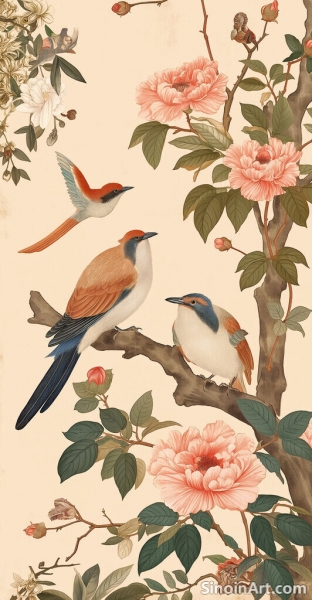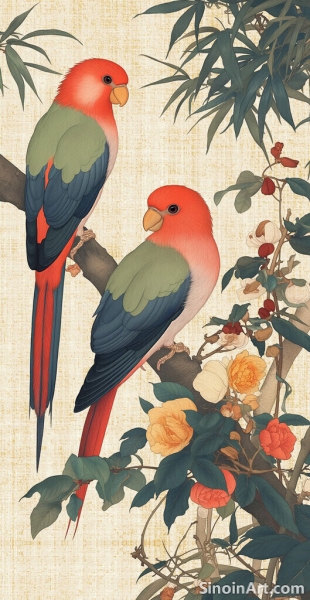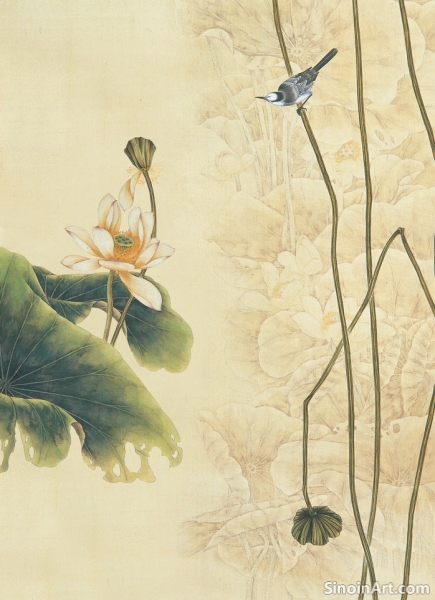Gongbi Painting and the Four Gentlemen: Symbolism in Nature
|
Within the rich tapestry of Gongbi painting, the representation of the “Four Gentlemen” – the plum blossom, orchid, bamboo, and chrysanthemum – holds a special significance. These plants are not merely aesthetic motifs; they are revered symbols of virtue and character in Chinese culture, each embodying unique qualities that resonate with the ideals of the scholar-gentleman. Understanding their symbolism is key to fully appreciate many traditional artworks.  The plum blossom, which blooms in the depths of winter, symbolizes resilience, perseverance, and courage in the face of adversity. Its delicate petals and fragrant blossoms are seen as a testament to the power of beauty to flourish even in the harshest conditions. This makes it a popular subject during Chinese New Year celebrations.  The orchid, with its subtle beauty and refined elegance, represents humility, grace, and integrity. Its understated charm and delicate fragrance are seen as symbols of inner purity and moral strength. It embodies the Confucian ideal of the “gentleman.”  Bamboo, with its upright stance and hollow core, symbolizes integrity, uprightness, and humility. Its ability to withstand strong winds and bend without breaking represents the resilience and flexibility of a noble character. It’s known for its ability to adapt and thrive. The chrysanthemum, which blooms in the autumn, symbolizes longevity, steadfastness, and resilience. Its late bloom is seen as a symbol of steadfastness and the ability to persevere through challenging times. It’s often associated with peace and tranquility. The Four Gentlemen are often depicted in Gongbi painting to embody these values and to serve as an inspiration for self-cultivation. They are not merely pretty pictures, but a powerful representation of cultural values. The act of painting them can be a kind of meditation on virtue itself. They serve as symbols that remind us of those values that we aspire to in ourselves. |
Tag : Four Gentlemen painting, Chinese flower symbolism, plum blossom, orchid art, bamboo painting, chrysanthemum symbolism
Related information
- The Meticulous Hand: Precision and Detail in Gongbi Painting
- The Role of the Artist's Seal in Gongbi Painting
- The Future of Gongbi: Innovation and Preservation
- Gongbi and the Depiction of Water: Capturing the Flow and Spirit
- Gongbi Painting and the Depiction of Clouds and Mist
Chinese Gongbi painting, distinguished by its meticulous detail and precise execution, stands as a testament to the dedication and technical skill of its practitioners. Unlike the expressive spontaneity of Xieyi (freehand) painting, Gongbi emphasizes a controlled and highly detailed approach, striving for a realistic depiction of the subject matter. This pursuit of perfection is central to the aesthetic and philosophy of the Gongbi tradition.
This article discusses the role of the artist's seal in Gongbi painting, highlighting its function as a signature, a visual element, a statement of ownership, and its contribution to the cultural significance and authenticity of the artwork.
This article discusses the future of Gongbi painting, highlighting the importance of both preserving traditional techniques and fostering innovation, and exploring the role of technology and globalization in ensuring the art form's continued relevance.
This article explores the depiction of water in Gongbi painting, highlighting the techniques used to capture its flow and movement, the use of color to suggest its depth, symbolic significance, and how it enhances the overall sense of harmony and balance within the artwork.
This article explores the depiction of clouds and mist in Gongbi painting, highlighting the techniques used to create a sense of depth, luminosity, and atmosphere, and how the subtle variations in color and tone evoke a sense of mystery and serenity.